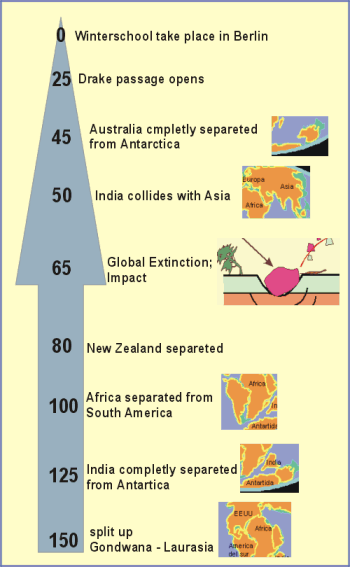Timeline
The following section highlights some major events that led to the formation and subsequent breakup of Gondwana.
Late Proterozoic
Breakup of supercontinent Rodinia; separation of Gondwana from North America.
Paleozoic
Gondwana remained a stable continent throughout this period.
Cambrian-Devonian: Gondwana occupied an equatorial position first, then moving southward. A major glaciation occurred during the Ordovician to early Silurian. Mountain building processes took place in Australia and Antarctica. During the Devonian, reef complexes developed along the continental margin of Australia.
Carboniferous-Permian: Another major glaciation took place during the late Carboniferous and early Permian. Gondwana and Laurasia combine to form Pangaea.
Mesozoic
Breakup of supercontinent Pangaea and separation of Gondwana into different individual continents (Australia, South America, India, Antarctica and Africa and Madagascar).
Jurassic: East Gondwana, comprising Antarctica-Madagascar-India-Australia, began to separate from West Gondwana, comprising Africa-South America.
Cretaceous: Africa separated from South America to form the South Atlantic and India separated from Antarctica. Asteroid/comet impact with final Cretaceous mass extinction. India started its rapid northward movement. Subsequent closure of Tethys Ocean.
Cenozoic
The major Alpine orogeny arranged continents anew.
Paleogene: India collided with Asia, resulting in the formation of the Himalayas. Antarctica and Australia separated and allowed the initiation of the circumpolar ocean current. Beginning of cooling and first glaciers on Antarctica.
Neogene: Alpine orogeny is still going on. Africa's Ethiopian and Kenian Domes started to rise. The East African rift valley formed and the Arabian peninsula split from the rest of Africa. Human evolution started in Africa. Australia moved northward along with New Zealand and New Guinea. The Quaternary ice age advanced inland ice shields several times. Vast glaciated areas on Antarctica became glaciated.
End of part 1.
Self-Evaluation
If you want to know how much you have learned, please click here to go to the test section.
